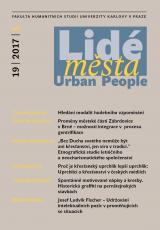Spontánně motivované nápisy a kresby
Historická graffiti na pernštejnských stavbách
DOI:
https://doi.org/10.14712/12128112.3333Klíčová slova:
writings, drawings, graffiti, symbols, signs, Prostějov, LitomyšlAbstrakt
This paper is focused on the study of historical spontaneously motivated writings and drawings, including modern history. The text presented here is based on the experience with the restoration of historical landmarks. At numerous sites, valuable historical surfaces, including those with writings, are being removed. In many cases, therefore, valuable resources that could help create a picture of one or more significant chapters of cultural history have disappeared forever. The aim of this contribution, among other things, is to highlight the value of spontaneously motivated writings as a historical resource. The text attempts to explain how we understand the concept of graffiti, and what significance historical writings and drawings have for our research. From the findings discovered at two structures of the House of Pernštejn, at Litomyšl Château and at Prostějov Château, we have attempted to describe and interpret preserved writings and drawings. The graffiti that we have found at both of these sites represents an exemplary set of the most often displayed symbols. However, there are also less common symbols or cartoons, the origin of which we are attempting to shed light on. Graffiti is reflected in many scientific fields, from art history to cultural history, sociology, archaeology, folklore studies, psychology, linguistics, epigraphy, landmark preservation, restoration, and heraldry. The expression “graffiti” is problematic due to its numerous connotations. It is a dynamic and constantly developing term. For the purposes of this text, we will understand it as consisting of writings and drawings originating from spontaneous thoughts, without lengthy consideration, using the most readily available means. The study of historical spontaneously motivated writings and drawings remains rather on the fringe of professional interest. Nonetheless, historical spontaneously motivated writings and drawings are a remarkable phenomenon that is not easy to grasp. Only some historical sources enable such close and intimate insight into the authors. Based on our observations, spontaneously motivated unofficial writings and drawings are created from random thought. To interpret them for their use in research in the humanities, it is necessary to get to know their environment and related historical events well, since only then can such messages be properly comprehended.
Stahování
Publikováno
Jak citovat
Číslo
Sekce
Licence

Tato práce je licencována pod Mezinárodní licencí Creative Commons Attribution-NonCommercial-NoDerivatives 4.0.


